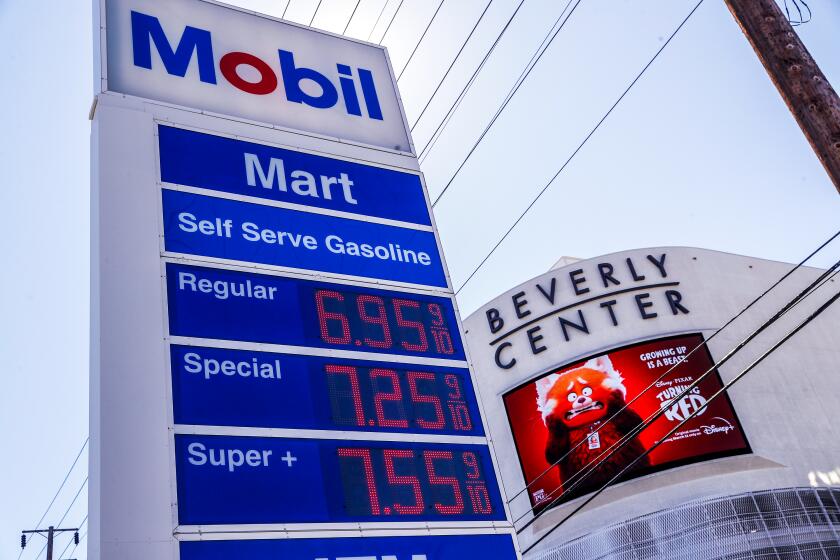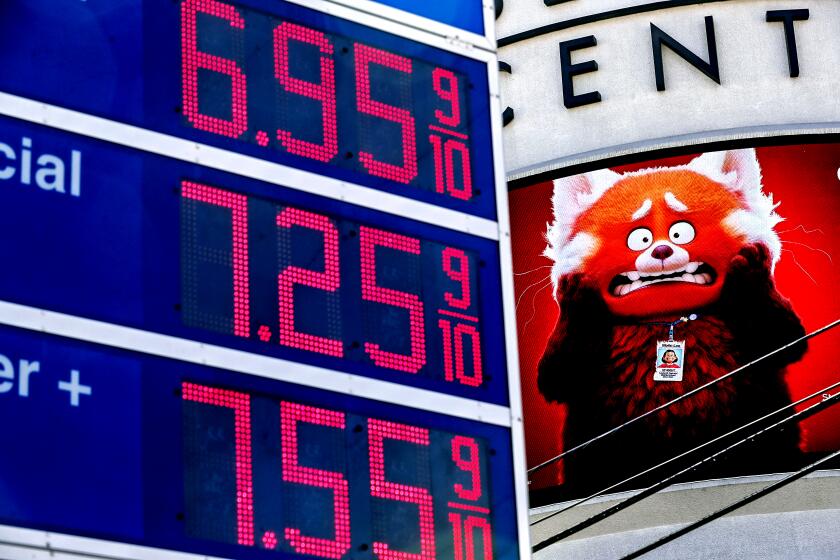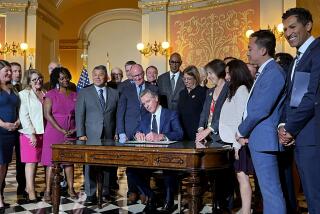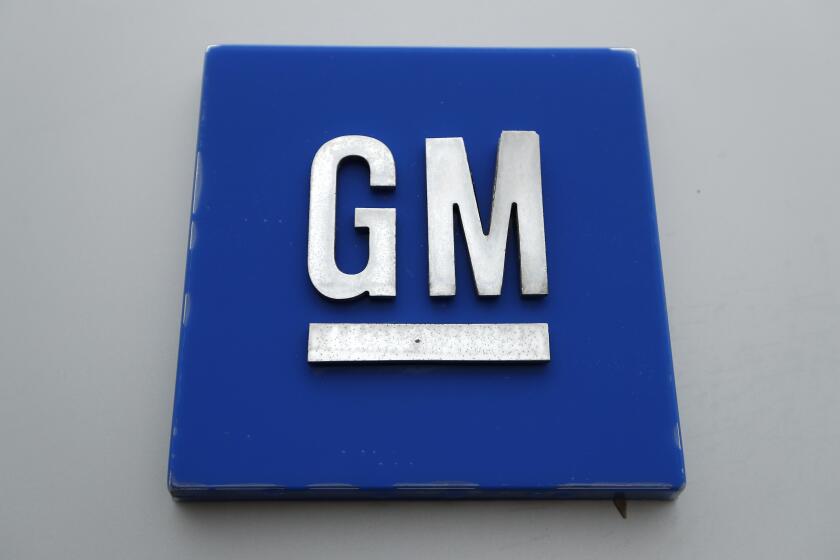Why are gas prices still so high? And what’s up with those rebate checks?
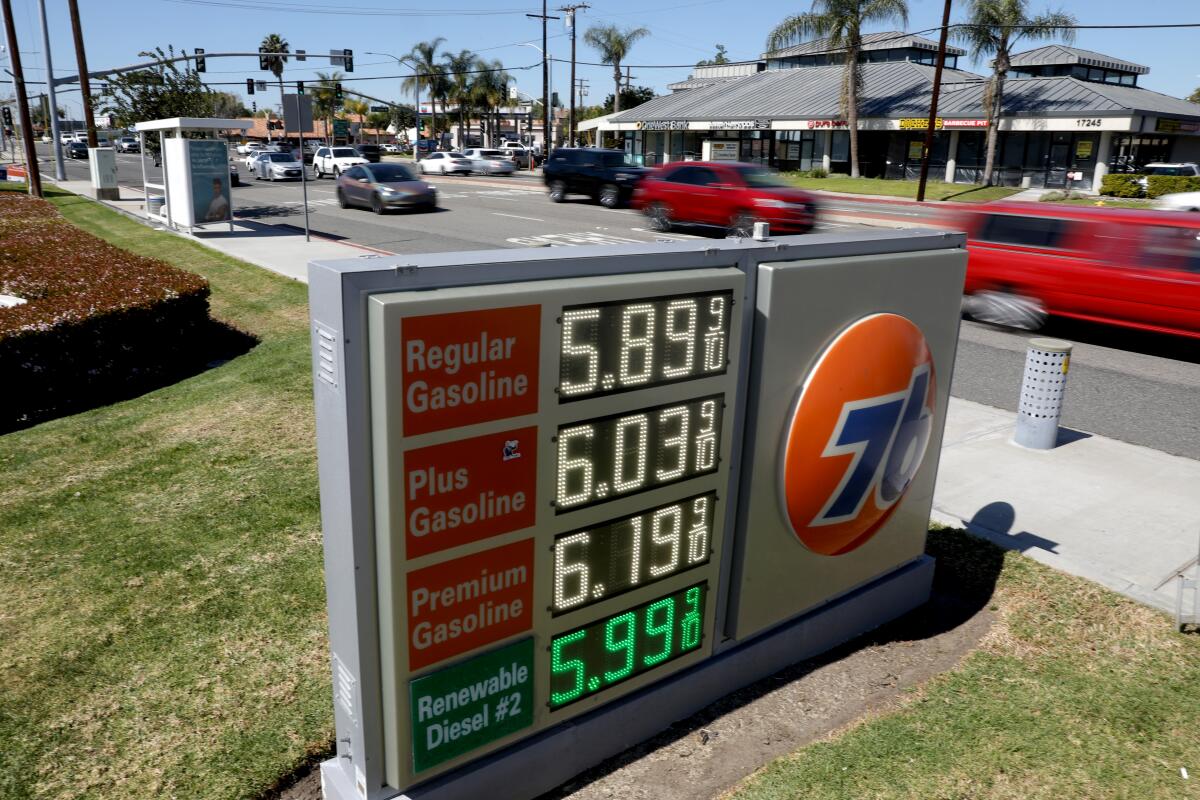
- Share via
For the last two months, Eric Simpson has been facing a dilemma: go surfing, or save gas for his commute?
Simpson, 26, works as a union ironworker — a rodbuster, to be precise. Recently he’s been commuting six days a week from his home in Fullerton to his job site in Universal City, where he lays down rebar for a new eight-story office building and six-story parking structure.
On Sundays, his one day off, he used to go surfing or fishing. But the gas math, on top of rising rent and grocery prices, has changed all that.
“If I drive to South County, that’s like a quarter of a tank, that’ll give me one day’s worth of commute,” Simpson said while filling up his four-cylinder Camry at an East Hollywood Arco on Thursday. “With my free time, am I going to go enjoy myself, go to the beach, go surfing, go see my buddy, or am I going to stay at home, save a couple bucks, and maybe have a nicer dinner on a Friday when I cook for the family?”
Lately, he’s been staying home.
L.A. gas prices started to shoot up on March 3, one week after Russia invaded Ukraine, as the war and international economic sanctions against Russia, a major oil and gas exporter, cast the global energy market into chaos. By March 9, the average price for a gallon of regular in L.A. climbed above $5.75. It hasn’t dipped below that price since.
You’ve seen the signs advertising $6.95, $6.99 or even $7.05 for a gallon of regular unleaded. But who’s buying it, and why?
Consumers may have expected that the U.S. decision to tap its strategic reserve, combined with reduced demand from China under a new round of COVID-19 lockdowns, would bring down prices at the pump, at least temporarily.
But the high prices have proved sticky and are unlikely to fall below $5 a gallon in the L.A. area anytime soon, according to industry analysts.
“We may not see consistently below $5 a gallon until there’s some long-term resolution between Russia and Ukraine,” said Patrick De Haan, head of petroleum analysis at GasBuddy.
The high price at the pump flows from the high — and highly volatile — price of crude oil. Locally, gas prices have also been affected by production issues at the refineries that produce California’s special blend of less-polluting gasoline.
“The volatility we’ve seen is wild,” De Haan added. The price per barrel of West Texas Intermediate crude, the benchmark often used for U.S. crude prices, has whipsawed more than 20% week by week since the war in Ukraine began, hitting a high above $123 a barrel only to slide below $95, then back up again.
International sanctions on Russia triggered the first spike in prices, as that country’s daily output of 9 million to 10 million barrels of oil seemed at risk of drying up from the global market. That prospect hit California especially hard, since the state’s refineries relied on Russian oil more than other U.S. regions.
Prices eased slightly when the U.S. and other governments decided to tap into strategic oil reserves in late March to increase supply, a move that President Biden said would, in tandem with other nations’ decisions to do the same, release 1 million additional barrels of oil per day for the next six months.
Broad lockdowns in Shanghai and other Chinese cities in response to new COVID-19 outbreaks brought prices down further, as traders anticipated a dip in energy demand. But news that China plans to test millions of people to reopen those cities sent prices back up soon afterward.
“The market is trying to digest all these factors that are significantly driving prices but changing day to day,” De Haan said. The result is that gas stations are keeping prices high, even if they decline slightly, since they can’t know whether prices will rocket back up tomorrow. “Stations would rather not lower prices than dip down and have to go back up later,” De Haan said.
L.A. gas prices may have also been affected by irregular output from the refineries that produce California’s low-emission gas blend. Output from the state’s refineries has been near a 15-year low over the last two months, if the outlier spring of 2020 — when the pandemic began and demand plummeted — is excluded from the data provided by the California Energy Commission.
A spokesperson for the state agency said in a statement that the low output is partly attributable to refinery outages but that “most temporary impacts resulting from unplanned outages have since been corrected.”
The state has been importing gas as well, however, and overall inventories have been rising in the state despite the lower refinery output — an indicator, the agency spokesperson said, that Californians may be consuming less gas overall in response to the high prices at the pump.
There’s no reason to believe that prices will decrease dramatically anytime soon, but there are some global events and local policy decisions that could help California consumers.
While the average price of gas nationwide peaked on March 11, L.A. County prices have continued to rise.
A new diplomatic agreement with Iran could drive prices back down by easing sanctions on that nation’s economy — including its large oil supplies — in exchange for limits on its nuclear research and development programs. But after signs of progress earlier this year, it remains unclear how close negotiators are to reaching a deal and how quickly any change could affect the oil market.
Meanwhile, California lawmakers have been wrangling over a sheaf of proposals that would reduce or suspend the state gas tax, or use the state’s projected $68-billion tax surplus to send direct payments to residents.
Gov. Gavin Newsom first proposed a plan in March to send $400 checks to registered California car owners, up to a maximum of $800 for owners of multiple vehicles, reduce the tax on diesel fuel for a year and pause the scheduled increase in taxes on gasoline. That increase is slated to take place in July and would increase the state excise taxes from 51 cents per gallon to 53.9 cents per gallon.
Newsom’s plan has stalled in Sacramento in the weeks since and came under criticism for benefiting only car owners and including cash benefits for wealthy Californians. A proposal by Republican state lawmakers to suspend the state gas tax entirely failed in March as well.
In late April, two more proposals emerged in Sacramento. One, from Democrats in the state Senate, addresses more than just gas price pain. This proposal would send checks to California families with adjusted annual incomes of less than $250,000, with $200 going to each taxpayer and an additional $200 for each child in a household, with additional subsidies going to low-income and disabled residents.
Another, from a small group of Democratic and Republican state lawmakers, returned to the idea of suspending the gas tax for a year and claimed to include a mechanism for ensuring that gas stations reduce prices accordingly, rather than keeping prices high and pocketing the difference.
The legislative deadline for stopping the planned inflation adjustment of the gas tax in July will pass on May 1.
Back at the East Hollywood Arco, where the cash price for a gallon of regular sat 13 cents below the regional average, at $5.65, other drivers said they weren’t changing their habits much because of high prices — yet.
Elvis León, a construction worker driving a 2022 Tacoma TRD 4x4, said that he was filling up his tank every two days thanks to a daily commute out to Redlands, where he’s installing the doors for the new Museum of Redlands.
“That’s 50 bucks a day,” León said, though he had worked out an agreement with his employer to cover the expense. He estimated he spent an additional $120 or so on gas for personal travel around town per week.
Jocelyn Carballo, driving a white CR-V, said she was eating the high gas prices herself and had to drive around central Los Angeles constantly for work, though she declined to say what her job was.
“The gas just seems to disappear,” she said, and she has to fill up two or three times each week. At over $5.75 a gallon, she was making ends meet, but any higher and she said something would have to give.
“It’s not sustainable,” Carballo said. “If it keeps going up, I’m just going to take the bus.”
More to Read
Inside the business of entertainment
The Wide Shot brings you news, analysis and insights on everything from streaming wars to production — and what it all means for the future.
You may occasionally receive promotional content from the Los Angeles Times.
